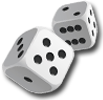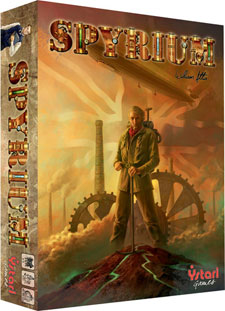



play board games
Board game reviews, strategy tips & session reports
Spyrium Board Game Review
 Stats:
Stats:
No. of players: 2-5
Amount of time to play: 60-90 min
Age requirements: 12+
Set-up time: 5 minutes
Spyrium is a steam-punk themed, worker placement game. You must mine spyrium (a mineral with high energetic efficiency), build factories and process it for VPs. If you have the most VPs after six rounds, you win.
Spyrium Rules Description:
You start Spyrium with three workers, eight British pounds and two spyrium crystals. There are nine cards laid out in the center of the table in a three by three grid. There are three types of cards, buildings, characters and techniques. You add buildings to your play area and may use them to gain spyrium, income, workers or VPs. Character cards give you a one-time addition of spyrium, income or VPs. Techniques give you a special ability and score you extra VPs at the end of the game.
Each round consists of two phases. In the first phase you place your workers and in the second phase you pull your workers or place them on your buildings. You can use the turn’s random event in either phase.
You must place workers, one at a time, between the nine cards. You want to place workers next to cards you want to use or purchase. But as you build buildings you can activate you must hold some back.
When you are ready to pull your workers back or place them on your buildings you move into phase two. This can happen at a different time for each player. Pulling a worker from next to a card lets you buy it if it a building or technique card or use it if it is a character card. The cost of any card increases by the number workers next to it after you pull your worker, including your own workers. Building plots cost one extra pound after the first you buy. So the more buildings you buy, the more expensive they are.
Once bought, you can activate a building once per round. Some of the buildings require workers to activate.
The last option you have when pulling a worker is earning money. You pull your worker and get one pound for each worker still around a card adjacent to the worker you pulled.
After all player pass the round is over. The cards in the middle are removed and nine new cards are put in the center of the table. Players start a new round and earn their income value in pounds.
Some card values use a random token valued one to three. This can be a card’s cost, VP value or spyrium it grants you. On most cards that call for tokens, you place one less token then there are players. When you use the card you pull a token and use that token’s value when interacting with the card.
After six rounds the game ends, you add any VPs you get from your buildings and any bonuses from your techniques. The player with the most VPs wins.
Quick Review of Spyrium:
Spyrium is a fun worker placement game with unique economy creation. You must weigh placing more people to take more actions versus taking a card you want. There are many tense decisions and a variety of ways to win.
The components for the game are high quality. Everything looks great and is well-made. The rules are easy to read and have lots of useful examples.
I really like the way you place workers and how that affects the price of the cards. Sometimes you will just place a worker next to a crowded card to pull it and earn some quick cash.
There are three decks of cards. The first three rounds of the game are played with deck A. The next two are played with deck B and the last with deck C. The cards get progressively more powerful and the game really ramps up. Decks A and B also include more cards then you use. This adds to the replay value of the game.
I have played this game with two, three and five players. And while it scales well it is better with more.
Spyrium’s theme is not too relevant and there is little steampunk feel to the game. This is not a big deal but if you are interested in this game for the theme you may want to try it first. If you like worker placement games you should definitely give this a try. It has some unique elements that should give it a place on your shelf.
Score and synopsis: (Click here for an explanation of these review categories.)
Strategy 4 out of 6
Luck 3 out of 6
Player Interaction 5 out of 6
Replay Value 5 out of 6
Complexity 4 out of 6
Fun 5 out of 6
Overall 5 out of 6

Leave a Reply